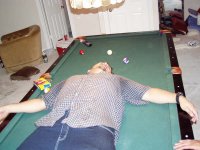1. Problem, when you use english and aim at the far center diamond, the cue ball does not hit the far center diamond, but will hit one or two inches off the mark. (using cue ball only, no object ball)
2. By placing your bridge hand about 9 inches back from the tip, aiming at the far center diamond with a center hit, then pivoting your back hand slightly to apply english, the cue ball will probably hit closer to the far center diamond (when not using a low deflection shaft like Predator). Where you place your hand to get no deflection or squirt is called the pivot point. Experiment by moving your hand closer to the tip or further away.
3. On page 10 of the Shepard squirt paper is the section called "Squirt Measurements". This details how to test for cue ball deflection.
4. Platinum Billiards lists "pivot points" for various cues, however some disagree as to the accuracy of these pivot points. For example they list a Predator 314 as having a pivot point of 11.9 inches back from the tip. I have a Predator 314 shaft and it seems to me that the pivot point is back near the butt of my cue. In general the more mass, the closer to the tip the pivot point will be, the less mass, the further back the pivot point will be.
https://www.platinumbilliards.com/rating_deflect.php
5. I have read that tip radius (nickel, dime, etc.) might have an effect on squirt. I have not seen the results of any testing for this anywhere.
6. See the following patent, part of which *includes* the hole in the end of the shaft/ferrule.
http://patft.uspto.gov/netacgi/nph-...,725,437.WKU.&OS=PN/5,725,437&RS=PN/5,725,437
7. Search google.com groups (Usenet) group rec.sport.billiard for deflection...
http://groups.google.ca/groups?hl=en&lr=&q=deflection&btnG=Search&meta=group=rec.sport.billiard
8. High speed videos of squirt...
http://www.engr.colostate.edu/~dga/pool/high_speed_videos/HSV4-4.htm
http://www.engr.colostate.edu/~dga/pool/high_speed_videos/HSV4-5.htm
9. So far as I am concerned, I just want the cue ball to go where I am aiming when using english. I can do this by placing my bridge hand on my regular cue about 10 inches back and moving my backhand to move the tip for english, then the cue ball will hit the far center diamond the same as a center hit. Or I can do this with my Predator 314 by moving my front hand left/right.
The bottom line is that I have a method of aiming when using english which sends the cue ball to the same spot as a center hit. Players who have been playing for years have learned to compensate for this or do not use english on long shots. Some of these players also have difficulty adjusting to a low deflection shaft.
